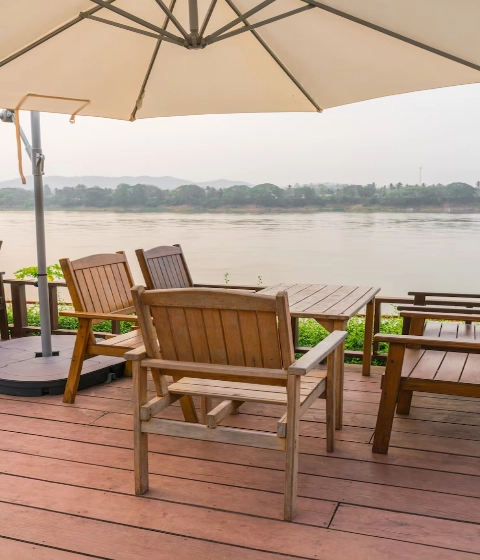How to Store Wooden Furniture Safely in Coastal Environments?

Coastal living offers stunning views and fresh sea air, but it poses unique challenges for storing wooden furniture. High humidity, salinity, and temperature fluctuations can damage wood, causing warping, mold, or corrosion. This guide provides expert tips to protect your furniture in coastal environments, ensuring longevity and beauty. Discover best practices and how FOREST delivers durable solutions for pet-friendly and coastal-ready furniture.
Why is Coastal Climate a Challenge for Wooden Furniture Storage?
Coastal areas pose a severe setting for wooden furniture. Salt, wetness, and temperature shifts hasten wear. Careful storage is essential to safeguard your prized possessions.
The Effects of High Humidity on Wood
Excessive dampness is a significant problem in coastal regions. Humidity frequently exceeds 70%. Wood, being porous, soaks up moisture. This leads to swelling and twisting. Such changes warp shapes and loosen bonds. Moist environments also promote mold and mildew growth. These blemish surfaces and weaken durability. Moreover, finishes like lacquer or paint may flake or bubble in humid conditions. This leaves wood vulnerable to further injury. Maintaining humidity between 40-60% is vital for preservation.
The Impact of Salinity on Wooden Surfaces
Salt particles, carried by sea breezes, settle on furniture. This saltiness erodes protective coatings. It exposes wood to moisture and UV harm. Extended exposure results in white, chalky spots or discoloration. Salt also degrades wood fibers over time. This renders surfaces fragile. Regular cleaning and protective sealants are crucial to counter these effects.
Temperature Fluctuations and Their Role in Wood Warping
Coastal zones often experience swift temperature changes, particularly during seasonal transitions. These variations make wood expand in warmth and contract in chill. Such shifts strain joints and cause splits. Uneven temperature exposure also deforms wood. This creates uneven surfaces or misaligned components. Adhesives in joints may weaken under thermal pressure. This compromises steadiness. Stable storage conditions are critical to reduce these problems.
What Are the Best Practices for Preparing Wooden Furniture for Storage?
Thorough preparation is key to protecting wooden furniture in coastal areas. Follow these steps to ensure your pieces remain in superb condition.
Cleaning and Treating the Wood Before Storage
Before storing, clean and treat furniture meticulously. This eliminates grime and enhances resilience. Use a moist cloth with a mild wood cleaner to remove dirt, salt, and dust. Dry completely to prevent trapped wetness. Apply polish or wax to seal the wood. This protects against drying or cracking. Allow several days for drying before storage. Inspect for scratches, dents, or loose joints. Fix them to avoid further deterioration.
Using Protective Coatings and Sealants
Protective coatings create a shield against moisture and salt. Marine-grade sealants provide UV and water resistance with a durable finish. Apply 2-3 layers and reapply every 1-2 years. Penetrating sealers offer deep moisture protection and stay breathable. Use them on unfinished wood, avoiding excessive coats. UV-protective stains maintain color and resist UV damage. Sand surfaces lightly before applying. Select products suited for coastal conditions. Ensure they permit air flow to prevent moisture buildup.
Disassembling Furniture to Reduce Stress on Joints
Breaking down furniture eases strain during storage. Detach legs, headboards, or shelves. This reduces pressure on joints. Store screws and bolts in labeled bags for simple reassembly. Wrap delicate parts in padding or bubble wrap. Then cover them with breathable fabric. This approach saves space and maintains strength, particularly for panel furniture.
Wrapping and Covering Techniques to Minimize Moisture Exposure
Effective covering prevents wetness and dust accumulation. Use breathable cotton sheets or specialized furniture covers. Avoid plastic, as it traps moisture and fosters mold. Fasten covers loosely to encourage air circulation. Elevate furniture on wooden pallets or cinder blocks. This blocks water seepage from concrete floors. These measures keep furniture dry and secure from coastal dampness.
How Can You Choose the Right Storage Environment for Wooden Furniture?
Selecting an appropriate storage area is crucial to address coastal challenges. This ensures furniture remains in excellent shape.
The Importance of Climate-Controlled Storage Units
Climate-controlled units are ideal for wooden furniture in coastal regions. They keep temperatures between 10-15°C and humidity at 40-60%. This prevents twisting and mold. They also protect furniture from extreme temperature shifts and high dampness. Such conditions can lead to cracking or swelling. Climate control is particularly important for antiques or heirlooms. It preserves original finishes. Investing in these units is cost-effective for safeguarding valuable items like FOREST’s premium wooden furniture.
Ventilation Requirements for Preventing Mold Growth
Proper ventilation is essential to prevent mold and mildew. Store furniture with at least 6 inches of space between pieces. This encourages air flow. Use portable dehumidifiers or silica gel packs in storage units. They absorb excess moisture. Avoid overcrowding, as it limits airflow. This creates damp areas that promote mold. Regularly inspect ventilation systems. This maintains a dry, mold-free environment.
Avoiding Direct Sunlight and Excessive Heat
Sunlight and heat intensify coastal storage challenges. Use UV-resistant window films or store furniture in shaded spots. This prevents fading and drying. Keep furniture away from heat sources like radiators. These can cause cracking. Opt for indoor storage over garages or sheds. Those spaces often retain heat. These steps protect wood finishes and ensure structural steadiness.
What Maintenance Steps Should Be Taken During Storage?
Consistent upkeep during storage keeps furniture in immaculate condition, even in coastal climates.
Regular Inspections to Detect Early Signs of Damage
Conduct regular checks to identify issues early. Inspect monthly for mold, twisting, or salt residue on surfaces. Ensure covers remain breathable and undamaged. Replace them if necessary. Verify screws and joints are secure. Tighten them as needed. Detecting problems early prevents minor issues from becoming expensive repairs.
Adjusting Storage Conditions Based on Seasonal Changes
Coastal climates vary with seasons. Adaptive storage strategies are required. In winter, increase dehumidifier use. This combats higher rainfall and humidity. In summer, enhance ventilation. This counters heat and moisture buildup. During transitional seasons, monitor temperature changes. Adjust climate controls accordingly. These adjustments ensure optimal conditions year-round.
Reapplying Protective Treatments as Needed
Protective coatings may wear off over time. Refresh marine-grade sealants or wax every 1-2 years, depending on exposure. Clean surfaces with a wood cleaner to remove dust or salt before reapplying. Test treatments on small, hidden areas first. This ensures compatibility. Regular reapplication bolsters resistance to coastal elements.

How Can FOREST Help with High-Quality Wooden Furniture?
FOREST is a reliable B2B furniture supplier. It specializes in robust, pet-friendly, and coastal-ready wooden furniture. With a commitment to excellence and innovation, FOREST offers solutions for harsh environments.
Overview of FOREST’s Expertise in Durable Wooden Furniture
FOREST merges masterful woodworking with earth-friendly resources to produce furnishings designed for shoreline homes. Every item undergoes extensive examination to guarantee protection against severe oceanfront elements. These include excessive dampness, salty breezes, and constant sunlight.
Commitment to Craftsmanship and Quality Materials
The company chooses superior timber varieties including teak, cedar, and acacia. These woods naturally repel wetness and bugs. Environmentally-aware, animal-friendly surface treatments provide extra shielding. They also keep ecological impact low. Stronger builds with rigid supports and tight connections promise extended usefulness. This makes them excellent for busy spaces and organizational needs.
Custom Solutions for Coastal Environment Challenges
FOREST focuses on made-to-order pieces for beachfront locations. These incorporate liquid-repelling applications and firmly closed connections to stop dampness entry. Adjustable component-based arrangements, like storage units and literature displays, enable convenient keeping and rearrangement. Personalized surface options, including boat-quality sealants or climate-proof tints, address both strength requirements and waterfront style tastes. Through specialized knowledge in extreme-setting furnishings, FOREST provides dependable answers for business clients.
Conclusion
Maintaining wood furnishings in seaside regions requires thoughtful preparation. Temperature-managed keeping areas and regular care prove vital. Fight dampness, salt damage, and heat variations through correct washing, coating, and taking apart. Choose atmosphere-regulated storage and periodic examinations to prolong service life. FOREST’s hardy, made-to-order timber products present a wise option, combining professional artistry with seaside suitability. Protect your purchase with these tested methods and FOREST’s superior goods.
FAQs About Storing Wooden Furniture in Coastal Areas
What Type of Wood is Most Resistant to Coastal Conditions?
Teak, cedar, and acacia are highly resilient in coastal settings. Their natural oils and density provide strength. Teak particularly resists moisture and salt. This makes it ideal for coastal storage. FOREST’s furniture often uses these woods for superior durability.
Can I Use Regular Tarps Instead of Specialized Covers?
Regular tarps are not recommended. They trap moisture, encouraging mold and twisting. Opt for breathable cotton sheets or specialized furniture covers. These allow air circulation. They also shield against dust and humidity.
How Often Should I Inspect Stored Wooden Furniture?
Inspect stored furniture monthly. Check for mold, twisting, or salt buildup. Inspect more frequently during rainy seasons or after storms. This maintains ideal conditions. It also prevents costly damage.

